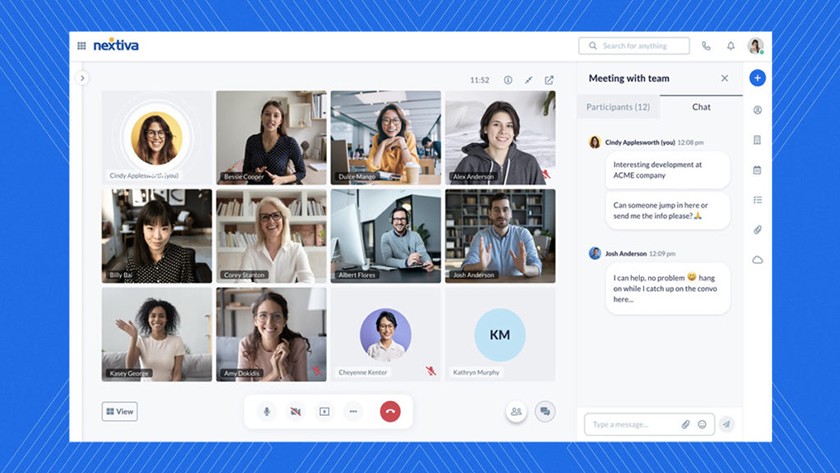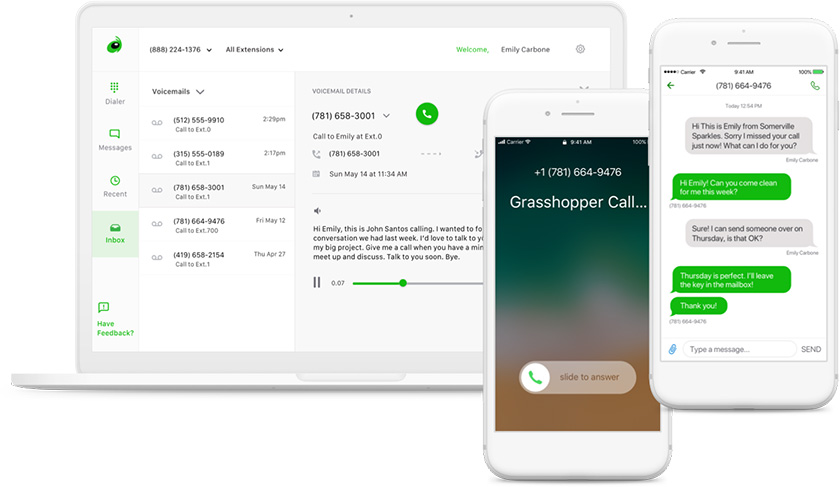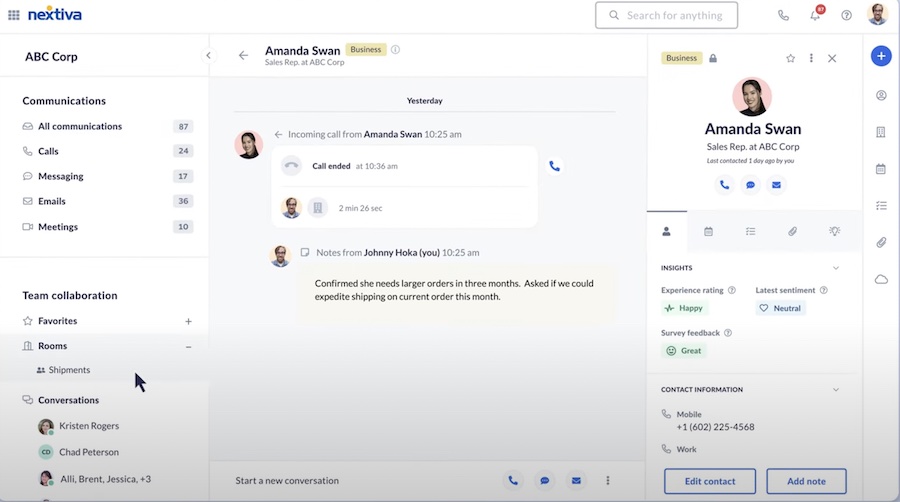Grasshopper and Nextiva are both cloud-based business phone solutions providing local numbers, unlimited voice calling, business texting, and voicemail. When comparing the two, Nextiva stands out because it provides an all-in-one solution for phone, video, instant messaging, collaboration, and customer engagement. On the other hand, Grasshopper is simply a virtual phone system with basic calling features accessible for a fixed monthly fee.
Based on our comparison, the best use cases for Nextiva vs Grasshopper are as follows:
- Nextiva: Ideal for larger teams wanting to manage all business communications in one collaboration platform
- Grasshopper: Best for small teams that want a basic, budget-friendly phone system with no per-user charges
For businesses in need of integrations, neither Grasshopper nor Nextiva are particularly powerful. We found a great alternative for those who need strong connectivity with third-party apps:
- RingCentral: Best for businesses with advanced integration needs. RingCentral connects to more than 200 applications
Nextiva vs Grasshopper at a Glance
Monthly Starting Price | $30.95 per user | $31 |
Free Trial | 7 days | 7 days |
Virtual Phone Numbers |
|
|
Unlimited Domestic Minutes | ✓ | ✓ |
Unlimited Video Calls | ✓ | ✕ |
Team Messaging | ✓ | ✕ |
SMS/MMS | ✓ | ✓ |
Auto-attendant | Multi-level | ✓ |
Integrations | Up to 20 third-party apps | ✕ |
For More Information |
Want to learn more about Grasshopper and Nextiva? Head on to our Nextiva review and Grasshopper review.
Best Alternatives
Aside from Grasshopper vs Nextiva, there are other cloud phone solutions out there with a more competitive feature set and cheaper pricing. Below we listed our top recommended voice-over-internet-protocol services (VoIPs) for small businesses:
A few Nextiva and Grasshopper alternatives include:
- RingCentral: It is a market-leading business phone system with extensive features for workplace communications and customer experience. Monthly pricing starts at $32.99 per user, which includes a host of productivity tools like team messaging, visual voicemail, and document sharing. It also integrates with 200-plus applications, allowing you to streamline workflows.
- Dialpad: It is a unified communications solution specializing in artificial intelligence (AI) capabilities like real-time transcription, sentiment analysis, and post-call summaries. Starting at $23 per user, per month, users have access to unlimited video meetings, SMS, visual voicemail, and real-time analytics—features typically offered by other providers at advanced tiers.
- Phone.com: It is a virtual phone system that lets you mix and match metered and unmetered call plans for greater cost savings. At only $14.99 per user monthly, Phone.com is best for businesses looking for an affordable phone solution with over 50 calling features on all plans.
Best for Pricing: Grasshopper
All plans include business texting, call forwarding, virtual fax, voicemail, instant response, custom greetings, call transfers, and reporting. Pricing is based on monthly billing for unlimited users. |
Rates are based on monthly per-user pricing and apply to one to four users. |
We give the crown to Grasshopper for this category due to its flat-rate pricing model—ideal for teams wanting to avoid per-user fees. The monthly cost stays the same regardless of the number of users connecting to its service. Pricing only varies based on how many phone numbers and extensions you need. Plus, all plans unlock the same features, including unlimited minutes, auto-attendant, voicemail, and text messaging.
Nextiva, on the other hand, charges on a “per user” basis starting at $30.95 per month. Prices get significantly higher if you add multiple users. Although Nextiva has more productivity tools, must-have features are locked behind advanced tiers, such as integrations, SMS, and audio conferencing. You’ll want to add five or more users or pay annually to get discounts.
Best for Calling Features: Nextiva
|
|
Nextiva clearly edges out Grasshopper as it offers extensive call management capabilities for handling high volume of incoming and outgoing calls. It has a visual call flow builder that lets you design how you want calls to be answered using a drag-and-drop mechanism. You can also set up call queuing, call screening, and priority alerts. Mobility features like call pulling, call forwarding, and presence give remote users the flexibility to answer calls anywhere.
Grasshopper, being a virtual phone service, tends to have fewer calling features since it’s intended for small businesses with low call volumes. Functionalities are limited to sending instant responses to missed calls, transferring calls to another number, and configuring answering rules for business hours. For call routing, Grasshopper lets you set up custom greetings and extensions for different departments.
Best for Collaboration: Nextiva
| Features are limited to calls and texts |
Nextiva beats Grasshopper for collaboration capabilities as it comes fully packed with productivity tools to help remote teams collaborate, automate repetitive tasks, and organize projects. The NextivaONE app provides a single platform for hosting meetings, sharing files, creating collaboration rooms, and monitoring tasks. Create notes on calls and contacts and use the search functionality on call transcriptions.

NextivaONE productivity tools include video conferencing, team chat, and file sharing. (Source: Nextiva)
Unfortunately, Grasshopper doesn’t have the same feature set, because as mentioned earlier, it essentially functions as a virtual phone system. This means its communication capabilities are limited to calling and texting.
Best for Ease of Use: Grasshopper
Grasshopper focuses on simplicity and functionality to ensure a quick setup process and integration with current workflows. | Nextiva provides a powerful application for high call volume environments. It puts all communications in one place, reducing the need to switch between channels. |
While it’s a close call, Grasshopper wins when it comes to usability, as it ensures simplicity and convenience from setup to deployment. Whether using a web browser or softphone app, Grasshopper provides quick access to messages, contacts, voicemail, and recent calls—no learning curve involved. This is best for businesses new to cloud phone systems and want to spend as little time as possible on employee training.

Grasshopper maintains a clean and straightforward design for its desktop and mobile apps. (Source: Grasshopper)
With its feature-rich interface, Nextiva may be overwhelming for businesses with simplified communication needs. Configuration is difficult for users with little to no experience in VoIP systems. There are also certain functions that require the intervention of its support team, specifically mobile and desktop app issues. However, once you understand the ins and outs of the NextivaONE app, it can be a powerful tool for everyday work communications.

Threaded conversations are the main highlight of the NextivaONE app, which lets you view all interactions with a customer in one place. (Source: Nextiva)
Best for Integrations: Nextiva
| Doesn’t directly integrate with third-party apps |
Nextiva takes the lead in this category as it connects with 21 third-party apps while Grasshopper has no integrations at all. Although it is not as robust as other competitors like RingCentral, Nextiva works with popular CRM apps and Salesforce, HubSpot, and Zendesk. The only catch is you need to upgrade your plan to unlock these integrations.
Grasshopper’s lack of integrations is best suited for small teams that don’t want to integrate their phone system with a third-party service. However, it’s necessary to consider what kind of programs your business uses so your VoIP system can work with them.
Best for Customer Reviews: Nextiva
|
|
Based on our expert assessment, Nextiva outshines Grasshopper in terms of feature set, customer service, and advanced capabilities. Several reviews about Nextiva reveal customers particularly like its NextivaONE app, collaboration tools, and call quality. It earned positive reviews for its responsive and outstanding customer service, while others complained about its steep pricing and configuration issues.
Looking at Grasshopper, the majority of reviews came from small business owners wanting to separate their work and personal calls. They find it competitively priced and easy to use, but the lack of advanced features is a common issue. While it performs well as a virtual phone system, its limited functionalities may not work well for scaling businesses needing a flexible communications solution.
Frequently Asked Questions (FAQs)
Can I use Grasshopper with a desk phone?
Yes. Grasshopper lets you forward incoming calls to your office phone or home office. You can also transfer your existing landline number to Grasshopper and use it to make outbound calls.
Do Nextiva & Grasshopper provide 24/7 customer support?
Both providers offer 24/7 access to their customer support team but differ in the type of support channels provided. You can reach Nextiva via phone, email, and live chat, while Grasshopper only has email.
Between Nextiva vs Grasshopper, which provider offers discounts?
Nextiva offers more discount options via annual billing and volume purchase, while Grasshopper offers no similar offering.
How We Evaluated Grasshopper vs Nextiva
We looked at free and paid plans from Grasshopper versus Nextiva to discover how the packages compare. We also tested each software and checked user feedback on popular review websites. From there, we created a scoring system based on the following categories: pricing, phone capabilities, collaboration features, ease of use, and integrations.
Here’s a complete breakdown of these factors:
Bottom Line
Nextiva and Grasshopper are reliable VoIP system providers that let you manage your business communications in one place. However, it’s important to note that these providers differ in the type of services they offer—Nextiva is a unified communications solution, while Grasshopper is a virtual phone system.
In our Nextiva vs Grasshopper comparison, Nextiva wins as it offers more functionalities for voice calls, video calls, text messaging, and collaboration, which provides excellent value for the money. However, if your business only requires basic phone features and wants to avoid per-user fees, Grasshopper is a much better option.